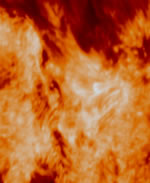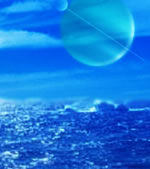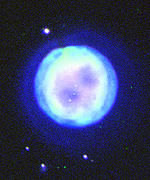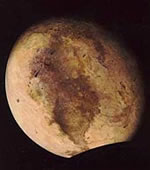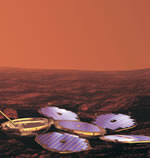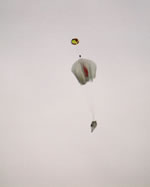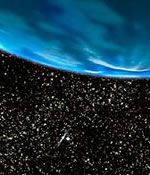
Image credit: Hubble
The Hubble Space Telescope was recently used to identify the oldest extrasolar planet ever discovered. The 2.5 Jupiter mass planet was originally discovered around a pulsar in the globular cluster M4 way back in 1988; astronomers detected a regular dimming of the pulsar’s radio wave emissions. By using Hubble, astronomers were better able to explain how the planet ended up around a pulsar. This discovery could reshape the current models of planetary development, which predicted that stars needed to go through at least one complete cycle to create the heavier elements that planets require.
Long before our Sun and Earth ever existed, a Jupiter-sized planet formed around a sun-like star. Now, 13 billion years later, NASA’s Hubble Space Telescope has precisely measured the mass of this farthest and oldest known planet. The ancient planet has had a remarkable history because it has wound up in an unlikely, rough neighborhood. It orbits a peculiar pair of burned-out stars in the crowded core of a globular star cluster.
The new Hubble findings close a decade of speculation and debate as to the true nature of this ancient world, which takes a century to complete each orbit. The planet is 2.5 times the mass of Jupiter. Its very existence provides tantalizing evidence that the first planets were formed rapidly, within a billion years of the Big Bang, leading astronomers to conclude that planets may be very abundant in the universe.
The planet now lies in the core of the ancient globular star cluster M4, located 5,600 light-years away in the summer constellation Scorpius. Globular clusters are deficient in heavier elements because they formed so early in the universe that heavier elements had not been cooked up in abundance in the nuclear furnaces of stars. Some astronomers have therefore argued that globular clusters cannot contain planets. This conclusion was bolstered in 1999 when Hubble failed to find close-orbiting “hot Jupiter”-type planets around the stars of the globular cluster 47 Tucanae. Now, it seems that astronomers were just looking in the wrong place, and that gas-giant worlds orbiting at greater distances from their stars could be common in globular clusters.
“Our Hubble measurement offers tantalizing evidence that planet formation processes are quite robust and efficient at making use of a small amount of heavier elements. This implies that planet formation happened very early in the universe,” says Steinn Sigurdsson of Pennsylvania State University.
“This is tremendously encouraging that planets are probably abundant in globular star clusters,” says Harvey Richer of the University of British Columbia. He bases this conclusion on the fact that a planet was uncovered in such an unlikely place, orbiting two captured stars ? a helium white dwarf and a rapidly spinning neutron star ? near the crowded core of a globular cluster, where fragile planetary systems tend to be ripped apart due to gravitational interactions with neighboring stars.
The story of this planet’s discovery began in 1988, when the pulsar, called PSR B1620-26, was discovered in M4. It is a neutron star spinning just under 100 times per second and emitting regular radio pulses like a lighthouse beam. The white dwarf was quickly found through its effect on the clock-like pulsar, as the two stars orbited each other twice per year. Sometime later, astronomers noticed further irregularities in the pulsar that implied that a third object was orbiting the others. This new object was suspected to be a planet, but it could also be a brown dwarf or a low-mass star. Debate over its true identity continued through the 1990s.
Sigurdsson, Richer, and their co-investigators settled the debate by at last measuring the planet’s actual mass through some ingenious celestial detective work. They had exquisite Hubble data from the mid-1990s, taken to study white dwarfs in M4. Sifting through these observations, they were able to detect the white dwarf orbiting the pulsar and measure its color and temperature. Using evolutionary models computed by Brad Hansen of the University of California, Los Angeles, the astronomers estimated the white dwarf’s mass. This in turn was compared to the amount of wobble in the pulsar’s signal, allowing the astronomers to calculate the tilt of the white dwarf’s orbit as seen from Earth. When combined with the radio studies of the wobbling pulsar, this critical piece of evidence told them the tilt of the planet’s orbit, too, and so the precise mass could at last be known. With a mass of only 2.5 Jupiters, the object is too small to be a star or brown dwarf, and must instead be a planet.
The planet has had a rough road over the last 13 billion years. When it was born, it probably orbited its youthful yellow sun at approximately the same distance Jupiter is from our Sun. The planet survived blistering ultraviolet radiation, supernova radiation, and shockwaves, which must have ravaged the young globular cluster in a furious firestorm of star birth in its early days. Around the time multi-celled life appeared on Earth, the planet and star were plunging into the core of M4. In this densely crowded region, the planet and its sun passed close to an ancient pulsar, formed in a supernova when the cluster was young, that had its own stellar companion. In a slow-motion gravitational dance, the sun and planet were captured by the pulsar, whose original companion was ejected into space and lost. The pulsar, sun, and planet were themselves flung by gravitational recoil into the less-dense outer regions of the cluster. Eventually, as the star aged it ballooned to a red giant and spilled matter onto the pulsar. The momentum carried with this matter caused the neutron star to “spin-up” and re-awaken as a millisecond pulsar. Meanwhile, the planet continued on its leisurely orbit at a distance of about 2 billion miles from the pair (approximately the same distance Uranus is from our Sun).
It is likely that the planet is a gas giant, without a solid surface like the Earth. Because it was formed so early in the life of the universe, it probably doesn’t have abundant quantities of elements such as carbon and oxygen. For these reasons, it is very improbable the planet would host life. Even if life arose on, for example, a solid moon orbiting the planet, it is unlikely to have survived the intense X-ray blast that would have accompanied the spin-up of the pulsar. Regrettably, it is unlikely that any civilization witnessed and recorded the dramatic history of this planet, which began at nearly the beginning of time itself.
Original Source: Hubble News Release

